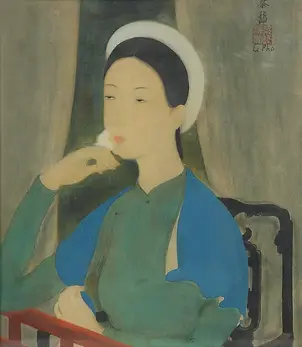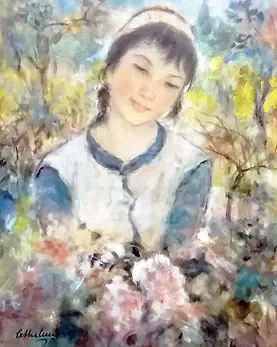
Glossary of artists
This glossary presents a selection of artists who have marked the history of art in Asia or who have been profoundly influenced by the continent. It provides an overview of the diversity of artistic expressions and aesthetic movements that have shaped Asian cultures.

Pham Hau, a renowned Vietnamese artist, has left an indelible mark on the field of lacquerware, distinguishing himself through his exceptional expertise in this traditional Vietnamese art.
Born in 1903 in a village in Dông Ngac, Vietnam, the young Pham Hau began his early years as an apprentice in the workshop of Nam Son (Nguyen Van Tho, 1890-1973), whom...

Adrien-Jean Le Mayeur de Merprès, born in Brussels in 1880 and died in the same city in 1958, was a Belgian painter whose work was deeply influenced by his travels, and more particularly by his stay in Bali, Indonesia, where he spent the last 26 years of his life. The son of a renowned seascape painter, he initially studied architecture before returning to painting, his true passion...

Antonio Maria Blanco, born on 15 September 1911 in Manila, the capital of the Philippines, is one of the most emblematic artists to have left his mark on the history of Bali. Descended from Spanish parents, Blanco claimed a spiritual and geographical link with Surrealist masters such as Salvador Dalí and Joan Miró. This Iberian heritage nurtured his style, but it was on the island of Bali, his ultimate...

Born in Nanchong in the Chinese province of Sichuan, he came from a wealthy family that owned a large silk weaving factory. Introduced to art at an early age, he initially took drawing and calligraphy lessons from his father and the famous calligrapher Zhao Xi. Following a trip to Japan between 1918 and 1919, he studied at Shanghai University. Like many...

Born in 1870 in Orliénas, in the Rhône region, Victor Tardieu quickly turned to a career in art. After studying in Lyon and Paris, he tried his hand at a variety of genres, from portraiture to landscape, but never found his true calling. In 1909, he received his first major public commission: to decorate the community room at Les Lilas town hall. This work brought him a certain...

A student at the Indochina School of Fine Arts in Hanoi, founded by Victor Tardieu in the 1930s, he was sent to France to continue his artistic studies alongside other students such as Mai Trung Thu, Le Pho and Le Thi Luu, who went on to make a career for themselves in Paris. Born in Hanoi, he entered the Indochina School of Fine Arts in 1926. There he studied drawing, painting...

Born in Xuzhou, Jiangsu Province to illiterate parents, Keran studied painting alongside a local painter from an early age and then continued his studies at the Shanghai Academy from where he graduated in 1925. In 1929, he entered the National Academy of Arts in Hangzhou to study Western arts. The academy was then directed by Lin Fengmian who taught Keran oil painting....

A teacher at the Gia Dinh School of Fine Arts in southern Vietnam between 1955 and 1975, Nguyen Van Ro was one of the few great Vietnamese artists who decided to remain in their native country despite the period of the War of Independence, when he chose to teach his speciality, lacquer. He trained artists such as Nguyen Van Minh (1930-2014) Do you own a painting or a panel...

Born in Guanzhuang, in Zhejiang province, he began his studies at the First Normal School of Zhejiang. He then studied painting alongside Wu Changshuo. He taught at the Shanghai Academy of Fine Arts in 1924 and was subsequently appointed director of the National Academy (now the Zhejiang Academy of Fine Arts). Do you have an ink painting, a watercolor...

Born in the village of Ge Dong Ling in Guangdong province, his interest in painting began at an early age. He was one of the young elite who benefited from the ‘work-study’ programme, which enabled him to travel to France. He visited Paris, where he came into contact with Chinese artists already living and working there, notably Xu Beihong. In 1920 he studied at the prestigious Ecole...

A student at the Ecole Supérieure des Beaux-Arts de l'Indochine from which he graduated in 1936, he specialised in silk painting. If you own a folding screen, a work, a print, a painting on silk, canvas, lacquered panel, folding screen or any other work by the Vietnamese artist Luu Van Sin, please contact us for a complimentary evaluation, estimate and learn about the possibilities for the...

Born in 1906 in Ro Nha, he was a member of the first class at the Indochina School of Fine Arts in Hanoi, along with Le Pho. During his education, he developed a particular style that would set him apart from his colleagues throughout his career. He painted with gouache on silk and applied patches of colour organised to form the clothes and fleshy parts of his subjects. In 1937, he visited...

A pioneer of lacquer work in Vietnam. In 1932, he studied at the Indochina School of Fine Arts, graduating five years later. He then lived in Hong Kong before moving to Saigon in 1954. Initially an oil painter on canvas, he then turned his attention to lacquerware, which is more closely linked to his country and his origins, of which he is very proud. He will then wear this...

Born in a small village on the outskirts of Shanghai, he studied medicine before turning to painting. He graduated from the Shanghai School of Art in 1941 and took part in his first exhibition in 1942. Initially renowned for his work as an illustrator, he later became famous for his paintings of Yunnan's ethnic minorities. Have you inherited an ink painting, watercolor, a scroll or a drawing from the Chinese...

Born in the town of Baitu, Anhui province, he entered the National School of Fine Arts in Hangzhou, Zhejiang province, graduating in 1941. There he studied under Pan Tianshou, and his classmates included future masters of Chinese painting such as Wu Guangzhong and Zao Wou-Ki. . They remained friends and continued their artistic careers in France where they bore the nickname...

Between 1925 and 1930, Le Pho studied at the Indochina School of Fine Arts. He was then awarded a scholarship to study in France at the Ecole des Beaux-Arts in Paris, where he studied under the teacher and artist Victor Tardieu. On his return to Vietnam, he taught at the Indochina School of Fine Arts in Hanoi. In 1937, he gave up his teaching post to...

Born in Guangzhou to 10 siblings, he was taken to Singapore by his father at an early age. While there, he earned a living from his art, then decided to move to Jakarta in Indonesia in 1932. From 1946 onwards, he exhibited regularly in Europe, notably in Paris. Sukarno, then President of Indonesia, was particularly fond of Man Fong's work, which he felt helped him to escape...

Born in Tho Khoi, in the province of Ha Bac, Le Thi Luu studied at the Indochina School of Fine Arts in 1927 and graduated five years later. During her studies she made friends with some of her classmates and future influential artists such as Le Pho, Mai Thu and Vu Cao Dam, as well as with her main teacher Victor Tardieu. During a trip to France, followed by a stay in...

Internationally renowned modern artist Yun Gee is a Chinese painter born in 1906 in the Guangdong region. His father was a merchant and entrepreneur living in the United States, and in 1921 he decided to join him there permanently. Four years later, he enrolled at the San Francisco School of Fine Arts, where he studied painting and drawing under the guidance of the artist Otis Oldfield, who became...

Born in Mo Cay in the province of Ben Tre into a wealthy family, Le Van De was the 10th child of 13 siblings. In 1925 he was admitted to the first class of the Ecole Supérieure des Beaux-Arts de l'Indochine, graduating in 1930. His specialities were silk painting, oil painting and fresco painting. In 1931 he was awarded a scholarship to study in France, where he attended the...

Born in 1923 in the village of Air, My Tho province, he passed the entrance exam to the Indochina School of Fine Arts in 1938. Together with other artists such as Nguyen Gia Tri and Nguyen Tu Nghiem, he made the art of lacquer one of the most renowned forms of expression in Vietnam. His favourite themes are life in general, war, revolution and the conflicts of his generation. He was...

Born in Marseille, Aymé studied music and drawing and was a pupil of the artist Maurice Denis. In 1920, she married her teacher, Paul de Fautereau-Vassel, whom she accompanied to Shanghai and Hanoi. She taught drawing at the French lycée in Hanoi. On her return to France in 1926, she separated from her husband and returned to Indochina on a mission commissioned by the...

Born in Dijon, he studied at the lycée and the Beaux-Arts in his home town before joining the ranks of the Ecole des Arts Décoratifs in Paris in 1909. A fervent Communist, he travelled to China in 1926 where he became a professor at the National Institute of Art in Peking at the start of the Revolution, then at the Chinese Academy of Art (Hangzhou) where he taught the painter Li Keran...

Born in the village of Kim Hoang, in the province of Ha Tay, Phai graduated from the Higher School of Fine Arts in Indochina in 1945. Between 1956 and 1957 he taught at the Hanoi School of Fine Arts. He was among the last generation of students from the Indochinese School of Fine Arts before the Revolutionary War broke out, along with other figures such as Nguyen Sang, Nguyen Tu Nghiem...

Born in Xinyu in Jiangxi province, he studied in Japan at the Tokyo School of Fine Arts in 1933. He was director of the Jiangsu Provincial Painting School and taught in the Art Department of the Central University (now Nanjing University). His landscape representations use a particular revolutionary technique of dots and ink, which enabled him to...

Born in the Siba district of Tokyo, Hasui Kawase (born Bunjiro Kawase) is one of the most important representatives of the Shin-Hanga movement in the 20th century. Born into a family of silk merchants, he developed a taste for drawing and landscapes during a stay in Shiobara, north of Tokyo. He began to learn how to draw, making sketches of nature and reproducing...

Born on 29 November 1904 in Romans in the Drôme, he was trained as a painter by his mother Isabelle Mège. His military career took him to Indochina in 1931. While there, he met Emperor Bao Dai and became friends with the painter Mai Thu. During his military career in Indochina, he pursued his passion for painting with a touch of oriental influence. His favourite subject was...

A landscape painter born in Marseilles in 1896, Joseph Inguimberty is best known for his role as a teacher at the École des Beaux-Arts d'Indochine in Hanoi. He began his apprenticeship in 1910 at the École des Beaux-Arts in Marseille and continued at the École Nationale des Arts Décoratifs in Paris from 1913. The First World War marked a pause in his career...